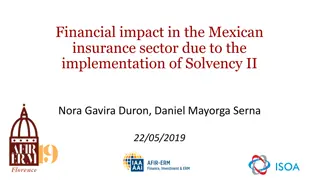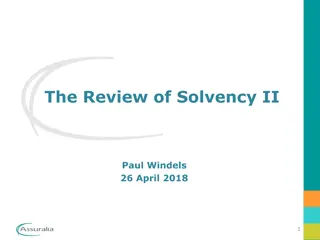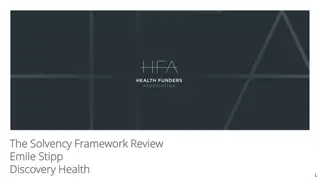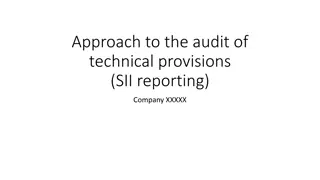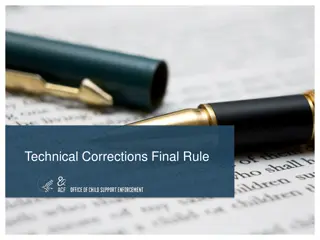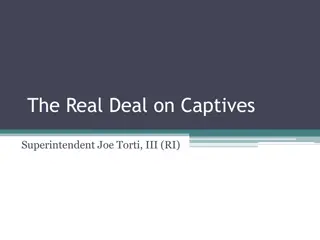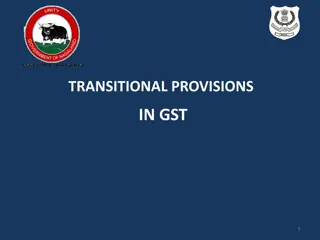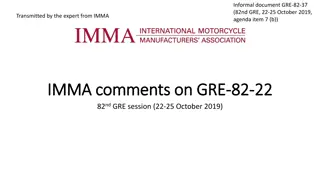Solvency II Changes in Technical Provisions by Luca Bianchi
In this presentation by Luca Bianchi on May 4, 2023, significant changes in technical provisions under Solvency II are discussed, including contract boundaries, divergent practices, stakeholder feedback, and amendments to guidelines. Specific areas covered include modeling biometric risk factors, investment management expenses, apportionment of expenses, changes in expenses, and dynamic policyholder behavior. Emphasis is placed on the importance of accurately assessing and modeling dynamic policyholder behavior in life insurance to make reliable profit projections. Expert judgment and statistical tools are essential for this assessment, even in the absence of historical empirical evidence.
Download Presentation

Please find below an Image/Link to download the presentation.
The content on the website is provided AS IS for your information and personal use only. It may not be sold, licensed, or shared on other websites without obtaining consent from the author.If you encounter any issues during the download, it is possible that the publisher has removed the file from their server.
You are allowed to download the files provided on this website for personal or commercial use, subject to the condition that they are used lawfully. All files are the property of their respective owners.
The content on the website is provided AS IS for your information and personal use only. It may not be sold, licensed, or shared on other websites without obtaining consent from the author.
E N D
Presentation Transcript
1 Solvency II changes in technical provisions, including contract boundaries Luca Bianchi May 4, 2023
Part 1: technical provisions New: 25, 28A, 37A, 37B, 37C, 40A, 0, 24A, 24B, 24C, 24D, 24E, 40B, 53A, 57A, 77A Amended: 30, 33, 77 6
Guidelines 37A. Dynamic Policyholder Behavior To identify its measure, the entity should use statistical tools on the base of empirical evidence As alternative, expert judgment is permitted, however, with the help of clear documentation. Since PHB is more evident under extreme [economic] scenarios, the lack of historical empirical evidence between those extreme [economic] events and lapses should not be considered alone to be a reason to avoid dynamic policyholder bahaviour modelling There s interaction between PHB and future management actions The last assessment is of a key importance in life insurance: it could easily make the best estimates raised in scenarios whose management actions make the future earning of declined. The more lapse rates in extreme scenarios when projecting profitable business in force, the higher the best estimate.
Guidelines 37C. Option to pay additional or different premiums
Guidelines 24A. Use of expert judgment (2/3) Examples are: Environmental issues such as global warming Legislative or political changes to be continued
Guidelines 24A. Use of expert judgment (3/3) Take into account materiality in EJ Usage of both quantitative and qualitative key indicators to understand materiality Usage of binary events and extreme scenarios to understand materiality Usage of events that are not present in the entity specific historical data
Guidelines 24B. Governance of assumptions setting Derivation includes the data underlying statistical analyses and the way to perform the statistical analyses
Guidelines 24C. Communication and uncertainty in assumptions setting For example, when lapse assumption are dealt with reference to surrenders, everybody should understand whether discussion is focussed on portfolio transfers (individual pension funds such as PIP) or reimbursement of term insurance linked to mortgage and loans which depend of ceased mortality risk (the mortgage or the loan has extinguished) rather than to a surrender of participating / unit linked contracts whose underpinning motivation of policyholders is financial. Users and providers of assumptions are separated and supply different roles. The Undertaking shall ensure there s a formal and documented process between providers and users of EJ and assumptions It s worth noting that actuarial function does coincide with neither users or providers, rather they are different parties by means 1st line operates and actuarial function is another (third) party with control function. The level of uncertainty of assumptions has to be transparent and the consequents variation in final results as well. The variation is meant to be the impact in the last or in the next reporting period. This is not a sensitivity. I believe the word includes, not only changes of technical provisions, also changes of Own Funds and changes in the SCR due to the feature that underwriting risks are valuated via shocks of best estimates. Also, future profits stemming from future new business and used (under a shock environment) to bear the Loss Absorbency Capacity of deferred taxes (LACDT) would be affected. As consequence, an info about the impact in solvency ratio may be useful
Guidelines 40B. Consideration of new business in setting future management actions (1/3)
Guidelines 40B. Consideration of new business in setting future management actions (2/3)
Guidelines 40B. Consideration of new business in setting future management actions (3/3)
Guidelines 57A. Market risk factors needed to deliver appropriate results
Guidelines 77 (amended). Assumptions used to calculate EPIFP (1/3)
Guidelines 77 (amended). Assumptions used to calculate EPIFP (2/3)
Guidelines 77 (amended). Assumptions used to calculate EPIFP (3/3)
Part 2: contract boundaries New: 0, 6A, 6B, 6C Amended: 5 37
Guidelines 6A, 6B, 6C. Identification of a financial guarantee of benefits, insurance risks with a discernible effect on the economic of a contract and changes over time
Guidelines 6A. Identification of a financial guarantee of benefits with a discernible effect on the economic of a contract
Guidelines 6B. Identification of a coverage for a specified uncertain event that adversely affects the insured person with a discernible effect on the economic of a contract
Guidelines 6C. Reassessment of a discernible effect of a cover or financial guarantee.







